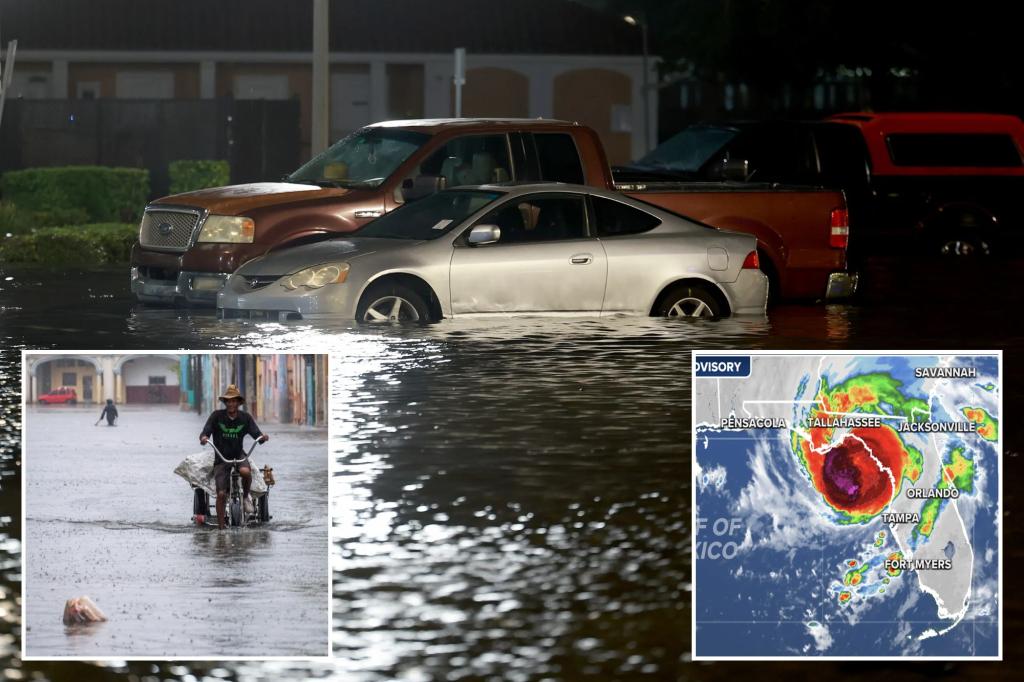Hurricane Idalia made landfall Wednesday morning in Florida as a dangerous Category 3 hurricane, promising to unleash “life-threatening” storm surges, damaging winds, and copious amounts of rain upon millions of Sunshine State residents.
Idalia, which has strengthened significantly in the past 24 hours, had briefly been categorized as a Category 4 storm before winds tapered off at a relentless 125 mph while making landfall just before 8 a.m. in Florida’s Big Bend region.
Officials with the National Hurricane Center still cautioned, “This change in wind speed does not diminish the threat of catastrophic storm surge and damaging winds.”
The threat of storm surges spans about 200 miles of Florida’s west coast, including the state’s Big Bend area, a sparsely populated area where the peninsula merges into the Panhandle, which was expecting anywhere from 12 to 16 feet of storm surge.


The looming threat of storm surge, as well as wind damage, has officials with the National Weather Service in Tallahassee warning that some places “may be uninhabitable for several weeks or months.”
Damaging winds had already left over 130,000 Floridians without power Wednesday morning as Idalia closed in on the state, PowerOutage.us shows.
The vicious storm — which had 14 million Floridians under hurricane and tropical storm warnings — dumped heavy rain over western Cuba before slamming down on Florida’s Gulf coast.
Gov. Ron DeSantis declared a state of emergency for 46 of the state’s 67 counties as thousands of National Guard troops were deployed to the area ahead of Idalia’s impact.
“If you are told to evacuate, you have to do that now,” he said during a Tuesday news briefing as evacuation orders were issued in 22 counties.

From Tuesday to Thursday, Florida’s Gulf Coast and southeastern portions of Georgia, North Carolina and South Carolina could face torrential rains of 4 to 8 inches. All face various hurricane, tropical storm and storm surge warnings and advisories.
Potentially “destructive life-threatening” winds are another concern, however, as the core of Idalia moves onshore through the Big Bend area, according to the National Hurricane Center.
More than 40 school districts across the impacted region have canceled classes, DeSantis said.
Tolls were being waived on highways out of the danger area on Tuesday as over 30,000 utility workers gathered ahead of the likely overload of power outages.


Tampa International Airport and St. Pete-Clearwater International Airport said they would close on Tuesday, and the Sunrail commuter rail service in Orlando was being suspended. Tampa International Airport will be closed indefinitely beginning Tuesday, and will not reopen until officials can assess damage from the storm.
The Orlando International Airport, closest to Walt Disney World Resorts, said Tuesday morning that they anticipate staying open even as the hurricane churns closer and closer to Florida’s coast.
“Our airport is open and operational. We continue to monitor the status of Hurricane #Idalia – we do not foresee any significant impact to our operations at this time. If operational changes occur, we’ll post about it. Please check with your airline in regards to your flight,” the airport wrote on X, the social media platform formerly known as Twitter.


Florida’s major theme parks, including Walt Disney World’s resorts, closed some attractions as Idalia barreled toward the state’s Big Bend region.
“We are closely monitoring the path of the projected weather as we continue to prioritize the safety of our Guests and Cast Members,” the resort announced.
President Biden on Monday said he had approved an emergency declaration for Florida.

Both Southwest Florida and Cuba are still recovering from Hurricane Ian, which was responsible for more than 100 deaths last year and left some Florida residents without power for over a month.
With Post wires
𝗖𝗿𝗲𝗱𝗶𝘁𝘀, 𝗖𝗼𝗽𝘆𝗿𝗶𝗴𝗵𝘁 & 𝗖𝗼𝘂𝗿𝘁𝗲𝘀𝘆: nypost.com
𝗙𝗼𝗿 𝗮𝗻𝘆 𝗰𝗼𝗺𝗽𝗹𝗮𝗶𝗻𝘁𝘀 𝗿𝗲𝗴𝗮𝗿𝗱𝗶𝗻𝗴 𝗗𝗠𝗖𝗔,
𝗣𝗹𝗲𝗮𝘀𝗲 𝘀𝗲𝗻𝗱 𝘂𝘀 𝗮𝗻 𝗲𝗺𝗮𝗶𝗹 𝗮𝘁 dmca@enspirers.com


